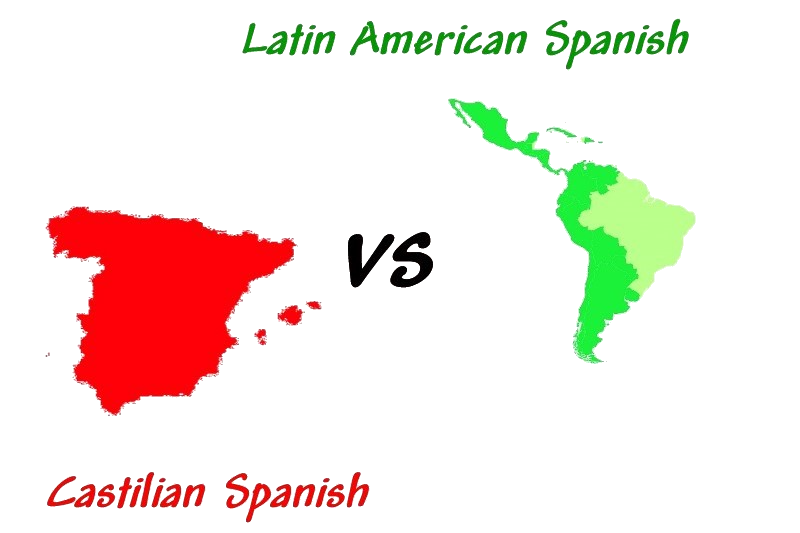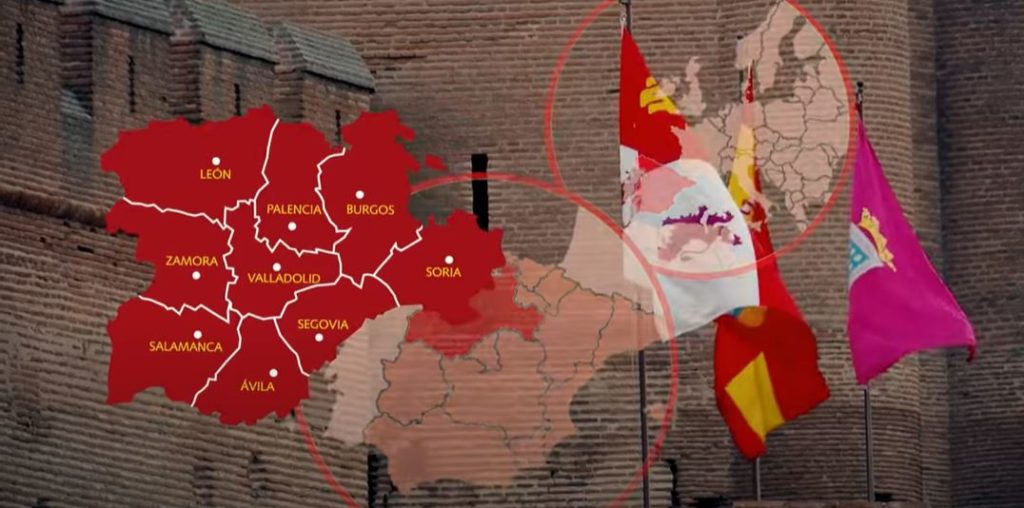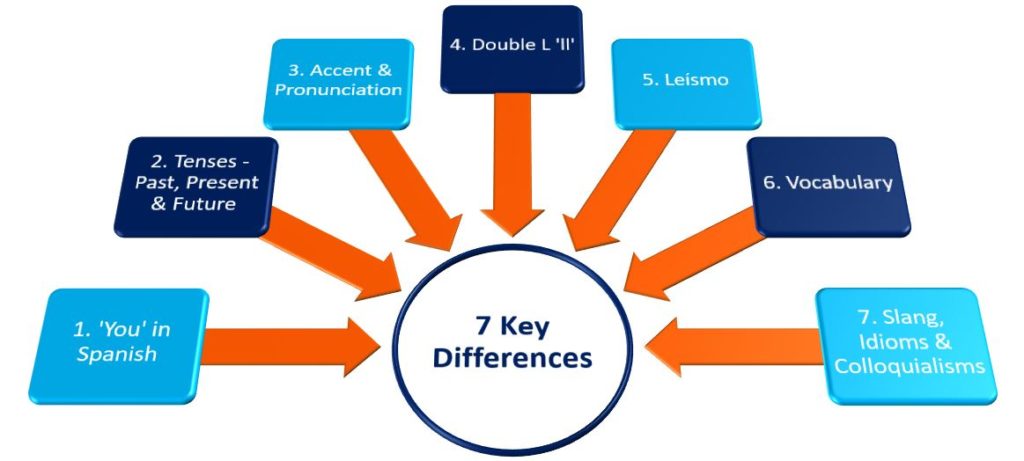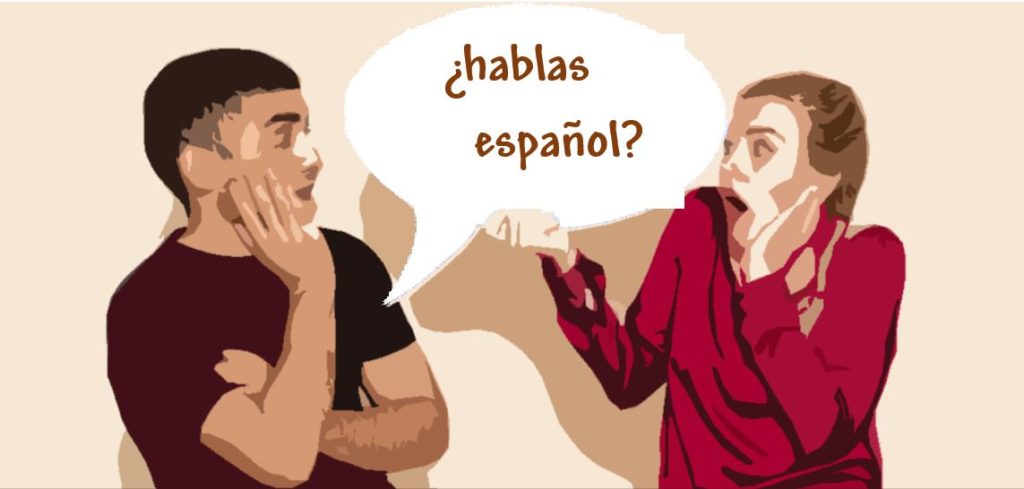
- What is Castilian Spanish Anyway?
- Where did Latin American Spanish Come From? – Quick History
- Castilian vs Latin American Spanish
- The 7 Key Differences Between Castilian and Latin American Spanish
- 1. How to Say ‘You’ in Spanish
- 2. Past, Present and Future Tenses
- 3. Accent and Pronunciation
- Spanish Accents – Seseo, Ceceo and Distinción
- 4. Pronunciation of the Double L “ll”
- 5. Leísmo – Lo(s) La(s) and Le(s)
- 6. Vocabulary – Different Words for the Same Thing!
- 7. Slang Idioms and Colloquialisms
- Quick Summary – Key Takeaways from What We’ve Learned.
- So Which Spanish Should You Learn – Castilian or Latin American?
- Frequently Asked Questions
- Related Posts
Before we get into the bones of our Castilian vs Latin American Spanish comparison, let me ask you a question . . .
Have you ever been to Scotland?
What?
Wait a minute, what’s Scotland got to do with Castilian and Latin American Spanish?
Let me explain . . .
If you have ever been spoken to by a true-blue Scot in Scotland (I have), you could find yourself wondering what just happened. You know they just spoke to you in English – because they speak English in Scotland – right!
You probably caught one or two words in there somewhere.
Their strong and different accent (different to yours anyway), and the speed they spoke at just threw you off. Like I did, you’d probably say something like – sorry? what? I beg your pardon?
The next time your Scottish friend speaks to you, you’d pay close attention and listen very carefully – you’d probably understand what they say.
This kind of thing happens in all languages – Spanish too.
The point I’m making is that the very same language spoken in two different countries can sometimes sound very different.
With the Spanish language you will notice these differences the most when you compare Castilian Spanish (Spain Spanish) to the Spanish spoken in Latin America.
In this post here on the Learn Spanish FAQs Blog we will take a close look at these differences. By the time you finish reading this article you will fully understand the main differences between Latin American and Castilian Spanish.
What is Castilian Spanish Anyway?
Castilian Spanish is the Spanish of mainland Spain. Referred to as Castellano by the Spaniards, Castilian Spanish gets its name from the Castile region of northern central Spain where the language originally came from.

Castilian Spanish goes by a few different names – which can sometimes be confusing to someone just starting out in learning the Spanish language. It is often called ‘Spain’ Spanish, Peninsular Spanish (from the Spanish or Iberian Peninsula) or European Spanish.
If you visit Spain and travel around a bit, you will find that some regions have their own sub-dialects of Spanish and other regions even have their own completely different local language.
Whenever you go to Spain and speak Spanish to the locals, most of the time and in most of the country, Castilian Spanish is the type of Spanish you will be answered with.
Where did Latin American Spanish Come From? – Quick History
So, what is Latin American Spanish? Well, Latin American Spanish, as we know it today, is the type of Spanish spoken in the Americas – from Mexico in the north all the way down to the southern tip of Argentina.
Short History Lesson – How Spanish was Brought to South America.

There you have it the origin and evolution of South American Spanish.
I did say ‘quick’ history!
Castilian vs Latin American Spanish
In the half a century or so that the Spanish of South America has been separated from its origins in Spain the language has changed a little here and there.
Even within South America itself Spanish has evolved just that little bit differently in each country.
It’s still the same Spanish though, and people from different Spanish speaking countries can easily understand each other.
But, like our Scottish example earlier, there can be some confusion initially as different people from different regions can sound very different even when speaking the same language.
The 7 Key Differences Between Castilian and Latin American Spanish
Everywhere Spanish is spoken you will find subtle differences in the language even at a local level between neighbouring regions. When comparing ‘Spain’ Spanish to South American Spanish there are differences that are not so subtle.n
There are seven major differences between Castilian Spanish and South American Spanish that really do stand out. Let’s take a look!

1. How to Say ‘You’ in Spanish
This is probably the biggest difference between Latin American and Castilian Spanish and likely the first one you’ll notice when you switch between the two. Just think about it, how often do you say the word ‘you’ in English?
I’ve used it twenty-nine times already in writing this article!
In Spanish there are three different ways to say ‘you’ when talking to one person (singular). There are two different ways to say ‘you’ when addressing a group (plural).
Which version of ‘you’ that you use will depend on where you are – South America or Spain.
‘You’ Plural – Ustedes vs Vosotros
In Spain when saying ‘you’ to a group of people you know, or maybe people the same age as you, or any group that there’s no reason to be especially respectful to, you’d use vosotros.
If on the other hand you are talking to any group that it might be considered polite to be respectful to, your grandparents maybe, your bosses at work or some government officials, you’d use ustedes.
In Latin American Spanish however, vosotros is rarely ever used. You would really only ever use ustedes when addressing a group in South American countries.
Example:
“Vosotros sois mis mejores amigos” (“you all are my best friends” – typical in Spain)
“Ustedes son mis mejores amigos.” (“you all are my best friends” – typical in Latin America)
‘You’ Singular – Usted, Tú and Vos.
With Castilian Spanish, when saying ‘you’ to one person, the singular form of ‘you’ – usted, is used. This is used when being respectful or polite to someone you are talking to.
When talking to someone you know, someone your equal or people younger than you for example you would use tú. Typically, in Spain you would use tú most of the time, only using usted when talking to someone of obvious importance.
In Latin America usted is used a lot more. In general, you would always address someone you don’t know with the more polite/formal usted. The more informal tú is generally reserved for talking to close friends and family.
A third way to say ‘you’ to a single person ‘vos’ can be encountered mostly in the southern cone countries of South America – Chile, Argentina, and Uruguay. This is also an informal version of ‘you’ known as voseo and would be used in the same way as tú.
Example:
“Usted es mi mejor amigo” (“you are my best friend” – formal, using “usted”)
“Tu eres mi mejor amigo” (“you are my best friend” – informal, using “tu”)
“Vos sos mi mejor amigo” (“you are my best friend” – informal, using “vos”)
2. Past, Present and Future Tenses
You will find that Castilian and Latin American Spanish speakers often use past, present and future tenses a little differently. Without getting too technical with grammar the easiest way to explain this is with an example.
Simple Past vs Present Perfect
When using the simple past you would say “something happened”, with the present perfect you would say “something has happened”. Adding the word has to the sentence makes use of the present tense to describe something that’s already happened.
Example:
Simple Past: “I ate my breakfast” “Comí mi desayuno”
Present Perfect: “I have eaten my breakfast” “He comido mi desayuno”
Latin Americans tend to use the simple past when they are talking about something that just happened. In Spain, Castilian Spanish speakers are more likely to make use of the present perfect. The use of the present perfect tense is a common trait of other European languages too.
Simple Future Tense vs Near Future Tense
Using the simple future, you would say “something will happen”. With the near future you would say “something is going to happen”.
Example:
Simple Future: “I will eat my breakfast” “Comeré mi desayuno”
Present Perfect: “I am going to eat my breakfast” “Voy a comer mi desayuno”
In Spain the simple future tense is more commonly used. In Latin America you are more likely to encounter the near future tense in use.
3. Accent and Pronunciation
Let’s say we are to take one English speaking person from each of, Sydney Australia, London England, and New York in the US. We will ask them the same few questions. I’m sure it would come as no surprise to you that when these three imagined people answer their questions each one will sound that little bit different to the next.
These three English speaking cities have distinct and recognisable accents – or at least recognisable to me (and probably you too), as someone who speaks English as their first language. Like our Scottish example earlier we can see that the same language spoken in different parts of the world can sound very different at times.
Now, let’s take three Spanish speaking cities, we’ll say, Madrid in Spain, Guadalajara in Mexico, and Buenos Aires in Argentina. You won’t be surprised when I tell you that each of these cities, separated by thousands of miles, have their own distinct Spanish accent.
To someone who speaks Spanish as their first language, these three different accents would be easily recognisable. But for someone like us, someone trying to learn Spanish, the differences in accent and pronunciation are not so obvious. Spanish just sounds like Spanish – right?
Not to worry though, there are a few things we can look out for! A few things that will give us a clue as to where the Spanish accent we are listening to might be from.

Spanish Accents – Seseo, Ceceo and Distinción
I’ll try to keep the grammar lesson here as simple as I can (who loves grammar – not me!).
Aside from different countries having their own accents, there are three main Spanish accent types or categories – grammatically speaking that is. They are distinción, ceceo and seseo. Most Spanish accents will fall into one of these accent categories.
Ceceo and the Spanish Lisp
Probably the biggest difference between Castilian Spanish and Latin American Spanish pronunciation, and definitely the easiest one to recognise, is something which is often called the Spanish Lisp.
This is where European Spanish speakers tend to pronounce any “s” and “c” which comes before an “e“ or an “i” as an English “th” sound. They also pronounce “z” with the same “th” sound. This type of pronunciation is known as ceceo and will make more sense with a few examples.
| Spanish Word | Latin American Pronunciation | Castilian Pronunciation | English Translation |
| ciudad | “see-you-dad” | “thi-you-dad” | city |
| gracias | “grasyas” | “grathyas” | thank you |
| centro | “sen-tro” | “then-tro” | center |
| zapatos | “sa-pa-tos” | “tha-pa-tos” | shoes |
| taza | “ta-sa” | “ta-tha” | cup |
| zorro | “sorro” | “thorro” | fox |
The Spanish word “ceceo” actually translates to “lisp” in English – hence the name Spanish Lisp. Understandably Spaniards don’t like the term Spanish Lisp so I wouldn’t mention it when travelling in Spain if I were you!
Seseo
Seseo which you could consider as the opposite of ceceo, is a category of Spanish accent which is widely used in South America. Seseo is where the “s” and “c” (before i and e) and the “z” are pronounced as an English “s” sound.
If you look at the table above the words “taza” pronounced “ta-sa” in South America (meaning cup) and “zorro” pronounced “sorro” in South America (meaning fox) would be examples of seseo.
This can cause some words which have completely different meanings to sound and be pronounced the same way. One example is “casa” (house) and “caza” (to hunt). The “z” in “caza” being pronounce as an “s” makes both of these words sound the same being pronounced “ca-sa”.
Seseo is not a problem for native Spanish speakers as they will easily understand the context. For someone learning Spanish this can be something to watch out for as it could cause confusion.
Distinción
This type of accent is a little less clear cut. With distinción the sound of the letter “s” is clearly differentiated from and pronounced differently than the letters “c” and “z”.
To recognise distinción in use we need to listen out for “s” being pronounced clearly as an English “s” sound and the “c” (following i and e) and “z” being pronounced with an English “th” sound (similar to ceceo).
4. Pronunciation of the Double L “ll”
Another pronunciation difference you’ll need to watch out for is the way that the double L “ll” is used in Spanish. Some South American countries pronounce their double L very differently to how it is pronounced in Spain.
It will probably come as no surprise to you that the double “ll” in Spanish is pronounced very differently to how it sounds in the English language – depending on where you are in the world it can take on a “y” sound, an “sh” sound or even a soft ”j” sound.
Castilian Spanish – Double L “ll” as “Y”
In Spain the double “ll” is pronounced as, and sounds just like the English letter “y”, as in the word “yes”. This type of pronunciation for the double L is considered the standard pronunciation in the Castilian dialect of Spanish.
To complicate our Latin American vs Castilian Spanish comparison a little, you will find that this pronunciation (“ll” as “y”) can be found in many parts of Latin America as well. It’s the southern part of South America where you’ll find a difference.
Latin American Spanish – Double L “ll” as “sh” or Soft “j”
In some South American countries – mostly the southern cone region of Uruguay, Argentina and Chile – the double L “ll” is pronounced as a soft “j” or “sh” sound. In some regions the double L even takes on an “i” or “ee” sound.
Example:
The Spanish word for rain, “lluvia” could be pronounced as either of “yuvia” or “juvia” or “shuvia” depending on where in the world you are!
I guess the key take away here is that most of the Spanish speaking world pronounce their “ll” as a “y” sound. In the Southern cone and Andean regions of Latin America they pronounce it differently!
5. Leísmo – Lo(s) La(s) and Le(s)
More grammar – yay! Bear with me though I’ll keep this as short and sweet as I can (I doubt if grammar can be sweet in any situation though).
In Spanish and most other European languages, ordinary objects take on a gender, they are either masculine or feminine. Basically, in Spanish when referring to a person (or people) or an object (or objects) there are different ways of saying “it”, “the” or “them” depending on whether the person/people or thing/things you are referring to are masculine or feminine.
In Spanish the pronouns “lo” and “los” are used for singular and plural masculine objects or people and “la” and “las” are used for singular and plural feminine gender situations. “Lo” and “la” are direct object pronouns and used when referring directly to or about something or someone. The indirect object pronoun in both masculine and feminine situations is “le” or “les” (singular or plural).
In Spain you will find what is known as “leísmo”. This is where Spaniards tend to use the indirect object pronoun “le” or “les” instead of “lo(s)” or “la(s)” in many situations. Grammatically speaking, this is the incorrect use of “le(s)” but is commonplace in Spain. You won’t encounter leísmo in Latin American Spanish speaking regions.
6. Vocabulary – Different Words for the Same Thing!
Now that you know there’s quite a few differences in grammar and pronunciation between Castilian and Latin American Spanish you probably won’t be surprised to learn that there’s differences in vocabulary as well – very different words or phrases that mean exactly the same thing!
| 10 Examples of Castilian vs Latin American Vocabulary |
|---|
| 1. In Castilian Spanish, the word for a computer mouse is “ratón,” while in Latin American Spanish it is “mause.” |
| 2. In Castilian Spanish, the word for car is “coche,” while in Latin American Spanish it is “carro” or sometimes “auto.” |
| 3. In Castilian Spanish, the word for candy is “caramelo,” while in Latin American Spanish it is “dulce.” |
| 4. In Castilian Spanish, the word for French fries is “patatas fritas,” while in Latin American Spanish it is “papas fritas.” |
| 5. In Castilian Spanish, the word for Juice is “zumo,” while in Latin American Spanish it is “jugó.” |
| 6. In Castilian Spanish, the word for cell phone is “móvil,” while in Latin American Spanish it is “celular.” |
| 7. In Castilian Spanish, the word for money is “dinero,” while in Latin American Spanish it is “plata.” |
| 8. In Castilian Spanish, the word for eraser is “goma,” while in Latin American Spanish it is “borrador.” |
| 9. In Castilian Spanish, the phrase for “to take a taxi” is “coger un taxi,” while in Latin American Spanish it is “tomar un taxi.” |
| 10. In Castilian Spanish, the word for pen is “bolígrafo,” while in Latin American Spanish it is “pluma.” |
These few differences in vocabulary between Castilian Spanish and Latin American Spanish are only the tip of the iceberg. There are many more you are likely to find when learning Spanish or travelling in Spanish speaking regions.
7. Slang Idioms and Colloquialisms
When switching between Castilian and Latin American Spanish you will not only have to navigate your way through the differences in grammar, vocabulary and pronunciation, you will also come across a range of words and expressions that are informal and specific to certain regions or groups.
These are slang, idioms and colloquialisms. Getting to grips with these can be tricky. On one hand they can help you sound more like a native speaker but on the other hand, if used inappropriately, they can cause offense or send the wrong message. I did say tricky!
Slang
Slang is an ever changing part of any language and will vary depending on the country or region you’re in. In Spain, “guay” is a popular slang term used to express that something is cool. But travel across the ocean to Latin America and you’ll hear “chévere” instead.
Idioms
Idioms are expressions whose meanings can’t really be understood from the individual words that make them up – like “over the moon” in English.
Spanish idioms are often used to express emotions or to describe situations in a humorous or imaginative way. For example, “estar hasta el gorro” literally means “to be up to the cap”, but it is used to describe someone who has reached their limit and can’t take any more.
Colloquialisms
Colloquialisms are specific to a particular region and are an integral part of everyday speech. In Mexico, a common greeting is “¿Qué onda?” while in Spain, the equivalent is “¿Qué tal?”
Quick Summary – Key Takeaways from What We’ve Learned.
So Which Spanish Should You Learn – Castilian or Latin American?
The quick answer here is, if you are going to Spain, learn Castilian Spanish, anywhere else, learn Latin American Spanish. I talk about this in a lot more detail in another article – What Type of Spanish Should I learn – Which Dialect?
There you have it, some of the main differences between Latin American and Castilian Spanish. If you were trying to figure out which Spanish to learn , hopefully you now have the answer (read my other article first though).
If you have been learning Castilian Spanish but are heading to South America, or vice versa, you now know some of the differences in accent, pronunciation, and grammar to watch out for!
Frequently Asked Questions
Related Posts
What Type of Spanish Should I Learn – Which Dialect?
Spanish For Beginners – How to Get Started With Spanish
Online Learning Vs Traditional Classroom Learning
For more great tips and ideas to help you learn Spanish why not visit our HOME Page or check out the Related Posts section above
- What Type of Spanish Should I Learn – Which Dialect? - September 20, 2023
- Spanish Dialects – How Many Types of Spanish are There? - September 20, 2023
- Castilian vs Latin American Spanish – What’s the Difference? - September 20, 2023




